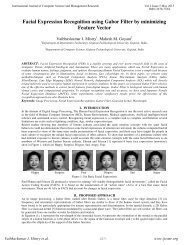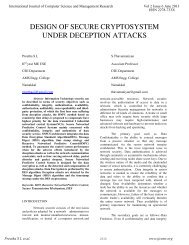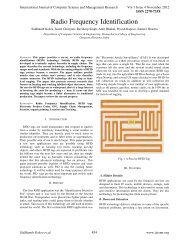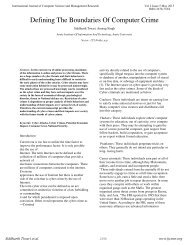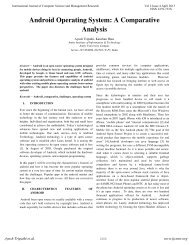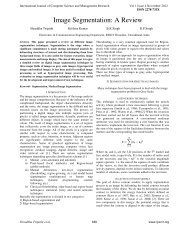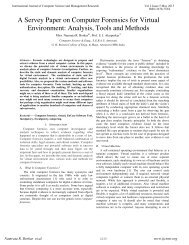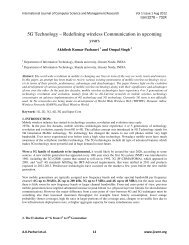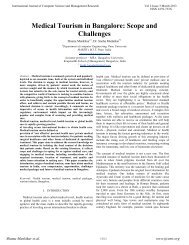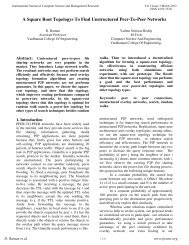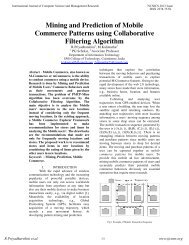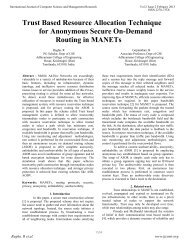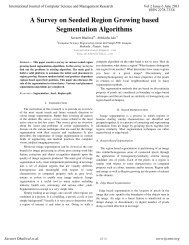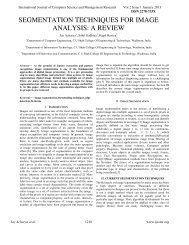Student Performance Prediction by Using Data Mining ... - ijcsmr
Student Performance Prediction by Using Data Mining ... - ijcsmr
Student Performance Prediction by Using Data Mining ... - ijcsmr
Create successful ePaper yourself
Turn your PDF publications into a flip-book with our unique Google optimized e-Paper software.
International Journal of Computer Science and Management Research Vol 1 Issue 4 November 2012<br />
ISSN 2278-733X<br />
<strong>Student</strong> <strong>Performance</strong> <strong>Prediction</strong> <strong>by</strong> <strong>Using</strong> <strong>Data</strong><br />
<strong>Mining</strong> Classification Algorithms<br />
Dorina Kabakchieva<br />
University of National and World Economy<br />
Sofia, Bulgaria<br />
Abstract— This paper presents the results from data mining<br />
research, performed at one of the famous and prestigious<br />
Bulgarian universities, with the main goal to reveal the high<br />
potential of data mining applications for university management<br />
and to contribute to more efficient university enrolment<br />
campaigns and to attracting the most desirable students. The<br />
research is focused on the development of data mining models for<br />
predicting student performance, based on their personal, preuniversity<br />
and university-performance characteristics. The<br />
dataset used for the research purposes includes data about<br />
students admitted to the university in three consecutive years.<br />
Several well known data mining classification algorithms,<br />
including a rule learner, a decision tree classifier, a neural<br />
network and a Nearest Neighbour classifier, are applied on the<br />
dataset. The performance of these algorithms is analyzed and<br />
compared.<br />
Keywords— Educational <strong>Data</strong> <strong>Mining</strong>, <strong>Student</strong> Profiling,<br />
Predicting <strong>Student</strong> <strong>Performance</strong>, Classification<br />
I. INTRODUCTION<br />
Universities today, similar to business organizations, are<br />
operating in a very dynamic and strongly competitive<br />
environment. The education globalization leads to more and<br />
better opportunities for students to receive high quality<br />
education at institutions all over the world. Universities are<br />
confronted with a severe competition among each other,<br />
trying to attract the most appropriate students who will<br />
successfully pass through the university educational process,<br />
and making efforts to cope with student retention. University<br />
management is very often forced to take quickly important<br />
decisions, and therefore timely and high quality information is<br />
needed.<br />
Modern universities are collecting large volumes of data<br />
referring to their students, the organization and management<br />
of the educational process, and other managerial issues.<br />
However, the available data is usually used for producing<br />
simple queries and traditional reports that are rarely reaching<br />
the right people at the right time for making informed<br />
decisions. Moreover, much of the data remains unused due to<br />
the inability of the university administration to handle it<br />
because of the large volumes and the increasing complexity.<br />
Advanced information technologies have to be introduced to<br />
effectively transform available data into information and<br />
knowledge to support decision making.<br />
<strong>Data</strong> mining, generally defined as the process of<br />
discovering meaningful patterns in large quantities of data,<br />
offers a great variety of techniques, methods and tools for<br />
thorough analysis of available data in various fields. The<br />
implementation of data mining in the educational sector,<br />
recently defined as “educational data mining” (EDM) [1], is a<br />
new stream in the data mining research field. The educational<br />
data mining research community is constantly growing,<br />
starting <strong>by</strong> organizing workshops since 2004, then conducting<br />
an annual International Conference on EDM beginning since<br />
2008, and now already having a Journal on EDM (the first<br />
issue being published in October 2009).<br />
There are already a large number of research papers<br />
discussing various problems within the higher education<br />
sector and providing examples for successful solutions<br />
reached <strong>by</strong> using data mining. Extensive literature reviews of<br />
the EDM research field are provided <strong>by</strong> Romero and Ventura<br />
in 2007 [1], covering the research efforts in the area between<br />
1995 and 2005, and <strong>by</strong> Baker and Yacef in 2009 [2], for the<br />
period after 2005. The problems that are most often attracting<br />
the attention of researchers and becoming the reasons for<br />
initiating data mining projects at higher education institutions<br />
are focused mainly on retention of students (<strong>by</strong> better<br />
knowing their peculiarities and needs, and <strong>by</strong> providing<br />
proper support in advance), more effective targeted marketing,<br />
improving institutional efficiency, and alumni management.<br />
The performed research work, presented in this paper,<br />
focuses on the development of data mining models for<br />
predicting student performance <strong>by</strong> using four data mining<br />
algorithms for classification – a Rule Learner, a Decision tree<br />
algorithm, a Neural network, and a K-Nearest Neighbour<br />
method. It is a continuation of previous research, carried out<br />
with the same dataset and with similar data mining algorithms,<br />
but for a different format of the predicted target variable. The<br />
achieved results from the performed research, using a target<br />
variable with five distinct values – Bad, Average, Good, Very<br />
Good, and Excellent, are previously published in [3]. Current<br />
research is implemented for a binary target variable.<br />
The rest of the paper is organized in four sections. The<br />
research motivation and the state-of-the-art are presented in<br />
Section 2. The adopted methodological approach, the<br />
experimentation data selection and pre-processing are<br />
described in Section 3. The obtained results from the<br />
application of the selected data mining algorithms are<br />
Dorina Kabakchieva 686 www.<strong>ijcsmr</strong>.org
International Journal of Computer Science and Management Research Vol 1 Issue 4 November 2012<br />
ISSN 2278-733X<br />
presented in Section 4. The paper concludes with a summary<br />
of the achievements and discussion of further research.<br />
II. RESEARCH MOTIVATION AND STATE OF THE ART<br />
The rationale behind the research work described in this<br />
paper is based on the great potential that is seen in using data<br />
mining methods and techniques for effective usage of<br />
university data. The discussions with high level managers and<br />
administrators of a famous and prestigious Bulgarian<br />
university have lead to the identification of existing needs for<br />
better knowing the students and performing more effective<br />
university marketing policy.<br />
The literature review reveals that these problems have been<br />
of interest for various researchers during the last few years.<br />
The development of data mining models for predicting student<br />
performance at various levels, and comparison of those<br />
models, are discussed in a number of research papers. In 2000<br />
the results of a study are described [4] aimed at finding weak<br />
students and involving them in additional courses for<br />
advanced support <strong>by</strong> extracting association rules from data.<br />
The retention of students is a problem discussed also <strong>by</strong> Luan,<br />
who implemented clustering, neural network and decisions<br />
tree methods to predict the students in risk of failure [5], [6].<br />
<strong>Data</strong> mining methods are implemented for modeling online<br />
student grades [7], using three classification approaches used<br />
(binary: pass/fail; 3-level: low, middle, high; and 9-level: from<br />
1 - lowest grade to 9 - highest score). Kotsiantis et al. [8] also<br />
deal with predicting student performance, recognizing<br />
dropout-prone students based on demographic characteristics<br />
(e.g. sex, age, marital status) and performance attributes (e.g.<br />
mark in a given assignment). Pardos et al. [9] use data from an<br />
online tutoring system for teaching Math and implement a<br />
regression approach for predicting the math test score based<br />
on individual skills. Super<strong>by</strong> et al. [10] predict students at risk<br />
of drop-out, determining factors influencing the achievement<br />
of the first-year university students, classifying students into<br />
three classes – low-risk, medium-risk and high-risk, using<br />
Decision trees, Random forest method, Neural networks and<br />
Linear discriminant analysis. Vandamme et al. [11] also deal<br />
with early identification of three categories of students: low,<br />
medium and high-risk students using Decision trees, Neural<br />
networks and Linear discriminant analysis. Cortez and Silva<br />
in [12] attempt to predict student failure <strong>by</strong> applying and<br />
comparing four data mining algorithms, Decision Tree,<br />
Random Forest, Neural Network and Support Vector Machine.<br />
The implementation of predictive modelling for maximizing<br />
student recruitment and retention is presented in the study of<br />
Noel-Levitz [13]. The development of enrolment prediction<br />
models based on student admissions data <strong>by</strong> applying different<br />
data mining methods (Decision trees, Rule induction, Feature<br />
subset selection) is the research focus of Nandeshwar [14].<br />
Dekker et al. [15] focus on predicting students drop out.<br />
Kovačić in [16] uses data mining techniques (feature selection<br />
and classification trees) to explore the socio-demographic<br />
variables (age, gender, ethnicity, education, work status, and<br />
disability) and study environment (course programme and<br />
course block) that may influence persistence or dropout of<br />
students, identifying the most important factors for student<br />
success and developing a profile of the typical successful and<br />
unsuccessful students. Ramaswami et al. in [17] focus on<br />
developing predictive data mining model to identify the slow<br />
learners and study the influence of the dominant factors on<br />
their academic performance, using the popular CHAID<br />
decision tree algorithm.<br />
III. RESEARCH APPROACH, DATA SELECTION AND PRE-<br />
PROCESSING<br />
The performed research is based on the CRISP-DM (Cross-<br />
Industry Standard Process for <strong>Data</strong> <strong>Mining</strong>) model, a nonpropriety,<br />
freely available, and application-neutral standard<br />
for data mining project implementation, widely used <strong>by</strong><br />
researchers in the data mining field during the last ten years<br />
[18]. It is a cyclic approach, including six main phases –<br />
Business understanding, <strong>Data</strong> understanding, <strong>Data</strong> preparation,<br />
Modelling, Evaluation and Deployment, with a number of<br />
internal feedback loops between the phases, resulting from the<br />
very complex non-linear nature of the data mining process and<br />
ensuring the achievement of consistent and reliable results.<br />
The open source software WEKA, offering a wide range of<br />
classification methods for data mining [19], is used as a data<br />
mining tool for the research implementation.<br />
First of all, the business problem is identified – it is the<br />
growing need of university management for better knowing<br />
the university students and predicting their performance in<br />
order to approach in the marketing campaigns exactly those<br />
students that will be most successful in the university<br />
education process. The stated business problem is transformed<br />
into a data mining task – the task for classifying students into<br />
two categories – successful and unsuccessful, <strong>by</strong> analysing the<br />
available student data with selected data mining methods for<br />
classification.<br />
The next phase in the research implementation includes the<br />
data selection and pre-processing, crucial activities within<br />
each data mining project, highly influencing the quality of the<br />
final results. After studying the application process for student<br />
enrollment at the University and reviewing the procedures for<br />
collecting and storing data about the academic performance of<br />
the university students, it is established that the university data<br />
is generally organized in two databases. All the data related to<br />
the university admission campaigns is stored in the University<br />
Admission database, including personal data of university<br />
applicants (names, addresses, secondary education scores,<br />
selected admission exams, etc.), data about the organization<br />
and performance of the admission exams, scores achieved <strong>by</strong><br />
the applicants at the admission exams, data related to the final<br />
classification of applicants and student admission, etc. All the<br />
data concerning student performance at the university is stored<br />
in the University <strong>Student</strong>s <strong>Performance</strong> database, including<br />
student personal and administrative data, the grades achieved<br />
at the exams on the different subjects, etc. For the purposes of<br />
the study, student data from both databases is carefully<br />
selected, extracted and combined in a new flat file (in this case<br />
Excel file) used for the data mining analysis in the WEKA<br />
software tool.<br />
Dorina Kabakchieva 687 www.<strong>ijcsmr</strong>.org
International Journal of Computer Science and Management Research Vol 1 Issue 4 November 2012<br />
ISSN 2278-733X<br />
The provided flat file contains data about 10330 students<br />
that have been enrolled as university students during the<br />
period between 2007 and 2009, described <strong>by</strong> 20 parameters,<br />
including gender, birth year, birth place, living place and<br />
country, type of previous education, profile and place of<br />
previous education, total score from previous education,<br />
university admittance exam and achieved score, total<br />
university score at the end of the first year, etc. The data is<br />
carefully studied and subjected to many transformations.<br />
Some of the parameters are removed, e.g. the “Birth place”<br />
and the “Place of living” fields containing data that is of no<br />
interest to the research, the “Country” field containing only<br />
one value (Bulgaria) because the data concerns only Bulgarian<br />
students, the “Type of previous education” field which has<br />
only one value as well because concerns only students who<br />
have finished secondary education. Some of the variables,<br />
containing important data for the research, are text fields<br />
where free text is being entered at the data collection stage.<br />
Therefore, these variables are processed and turned into<br />
nominal variables with a limited number of distinct values.<br />
Such a parameter is the “Profile of the secondary education”<br />
which is turned into a nominal variable with 9 distinct values<br />
(e.g. language, math, natural sciences, economics, technical,<br />
sports, arts, etc.). The “Place of secondary education” field is<br />
also preprocessed and transformed into a nominal variable<br />
with 7 distinct values, corresponding to the capital city and the<br />
6 geographic regions in Bulgaria – North-East, North-Central,<br />
North-West, South-East, South-Central, and South-West. A<br />
new numeric variable is added – the “<strong>Student</strong> age at<br />
enrollment”, calculated <strong>by</strong> subtracting the values contained in<br />
the “Admission year” and “Birth year” fields. Another<br />
important operation during the preprocessing phase is also the<br />
transformation of some variables from numeric to nominal<br />
(e.g. age, admission year, current semester, total university<br />
score, etc.) because they are much more informative when<br />
interpreted with their nominal values. The data is also being<br />
studied for missing values, which are very few and could not<br />
affect the results, and obvious mistakes, which are corrected.<br />
Essentially, the challenge in the presented data mining<br />
research is to predict the student university performance based<br />
on the available student pre-university and university<br />
performance data. This is achieved <strong>by</strong> solving a classification<br />
data mining task. A binary categorical target variable is<br />
constructed, based on the original numeric parameter<br />
“University average score” (the average numeric score<br />
achieved <strong>by</strong> the students at the end of the first year at the<br />
University). The predicted variable has two distinct values,<br />
corresponding to the two classes in which the students are<br />
classified – Weak and Strong. Since a six-level scale is used in<br />
the Bulgarian educational system for evaluation of student<br />
performance at schools and universities, the students with<br />
average university score that is lower than 4.50 are classified<br />
as “Weak”, and the students with average university score<br />
equal or higher than 4.50 are classified as “Strong”.<br />
The final dataset, on which the selected classification data<br />
mining algorithms are applied, contains 10067 instances and<br />
14 attributes (summarized in Table 1).<br />
TABLE I<br />
FINAL DATASET USED FOR THE DATA MINING ANALYSIS<br />
Type of <strong>Data</strong> Attribute Name Attribute<br />
Values<br />
Type<br />
Personal Gender Nom Male (49%), Female (51%)<br />
<strong>Data</strong><br />
Age Nom 29 distinct values (17-43,46,48,53) (18-21–95%, 19–78%)<br />
BirthYear Nom 29 distinct values<br />
Pre-University<br />
<strong>Data</strong><br />
University<br />
<strong>Data</strong><br />
PlacePrevEdu Nom 7 distinct values (Sofia, NE, NC, NW, SE, SC, SW)<br />
ProfilePrevEdu Nom 9 distinct values (Language, Natural_Math, Humanitarian,<br />
Economics, Technological, Business_Management, Arts,<br />
Sports, General)<br />
ScorePrevEdu Num 3.40-6.00<br />
AdmissionYear Nom 2007, 2008, 2009<br />
AdmissionExam Nom 5 distinct values (BG,Math,Geography, History,Economics)<br />
AdmissionExamScore Num 0.00-6.00<br />
AdmissionScore Num 0.00-35.98<br />
UnivSpecialtyName Nom 10 distinct values<br />
CurrentSemester Nom 1-10<br />
NumFailures Nom 0-12 (0 – 86,4%)<br />
<strong>Student</strong>Class Nom Weak (5340), Strong (4727)<br />
Most of the attributes (11), including the predicted class<br />
variable, are nominal variables accepting a certain number of<br />
distinct values, and only 3 of the attributes are numeric<br />
variables.<br />
IV. ACHIEVED RESULTS FROM THE DATA MINING<br />
ALGORITHMS IMPLEMENTATION<br />
During the Modeling Phase, the algorithms for building<br />
models that would classify the students into the two classes –<br />
Weak and Strong, depending on their university performance<br />
and based on the student pre-university data, are considered<br />
and selected. Popular WEKA classifiers (with their default<br />
settings unless specified otherwise) are used in the<br />
experimental study, including a rule learner (OneR), a<br />
common decision tree algorithm C4.5 (J48), a neural network<br />
(MultiLayer Perceptron), and a Nearest Neighbour algorithm<br />
(IBk). These classification algorithms are selected because<br />
they are very often used for research purposes and have<br />
potential to yield good results. Moreover, they use different<br />
approaches for generating the classification models, which<br />
increases the chances for finding a prediction model with high<br />
classification accuracy. The OneR Rule Learner algorithm<br />
produces a one-level decision tree expressed in the form of a<br />
set of rules that all test one particular attribute – the minimumclassification-error<br />
attribute. It is a simple, cheap method that<br />
often produces good rules with high accuracy. The Decision<br />
Tree algorithms generate models in the form of a tree-like<br />
structure, which starts from root attributes and ends with leaf<br />
nodes, describing the relationship among attributes and the<br />
relative importance of attributes. They represent rules which<br />
could easily be understood and interpreted <strong>by</strong> users, do not<br />
require complex data preparation, and perform well for<br />
numerical and categorical variables. Neural networks produce<br />
classification models in the form of a mathematical model,<br />
consisting of interconnected computational elements (neurons)<br />
and processing information using a connectionist approach to<br />
computation. They are used to model complex relationships<br />
between inputs and outputs and very often yield very good<br />
results. The K-Nearest Neighbor algorithm (k-NN) is a<br />
method for classifying instances based on measuring the<br />
distance between the classified instance and the closest<br />
training examples in the feature space. It is easily understood<br />
Dorina Kabakchieva 688 www.<strong>ijcsmr</strong>.org
International Journal of Computer Science and Management Research Vol 1 Issue 4 November 2012<br />
ISSN 2278-733X<br />
<strong>by</strong> users, often provides good classification results and<br />
performs well for large datasets.<br />
The selected data mining algorithms are applied to the<br />
dataset using the holdout method (WEKA “Percentage Split”<br />
test option, 66%/34%), as shown on Fig.1. The dataset is<br />
divided into 3 parts and, each time an algorithm is run, 2/3 of<br />
the data is used for training of the classification model and 1/3<br />
of the data is used for testing and evaluation of the model.<br />
<strong>Data</strong>set<br />
3/3<br />
<strong>Data</strong> Exploration<br />
and <strong>Data</strong> Pre-Processing<br />
Training <strong>Data</strong><br />
2/3<br />
Testing <strong>Data</strong><br />
1/3<br />
Results<br />
Fig. 1 <strong>Data</strong> <strong>Mining</strong> Algorithm Implementation - Classification Model<br />
The results from the evaluation of the classification models<br />
generated with the selected four data mining algorithms are<br />
presented in Table 2.<br />
TABLE III<br />
ACHIEVED RESULTS FROM THE DATA MINING ALGORITHM IMPLEMENTATION<br />
The four classification models, generated with the selected<br />
data mining algorithms, are compared <strong>by</strong> using the following<br />
evaluation measures: % of correctly/incorrectly classified<br />
instances, Kappa Statistic, True Positive (TP) and False<br />
Positive (FP) Rates, Precision, Recall, F-Measure and ROC<br />
Area. These are well known measures for evaluation of data<br />
mining models for classification.<br />
Fig. 2A Classifiers Accuracy Comparison<br />
Modeling<br />
<strong>Data</strong> <strong>Mining</strong><br />
Algorithm<br />
Classification<br />
Model<br />
Model Evaluation<br />
<strong>Data</strong> <strong>Mining</strong> Rule Learner (OneR) Decision Tree (J48) Neural Network K-Nearest Neighbour<br />
Algorithms<br />
(MultiLayer Perceptron - (IBk, k=50)<br />
1 hidden layer with 7<br />
neurons)<br />
Evaluation Weak Strong Weigh. Weak Strong Weigh. Weak Strong Weigh. Weak Strong Weigh.<br />
Parameters<br />
Av.<br />
Av.<br />
Av.<br />
Av.<br />
Corr. Classified<br />
67.4554% 72.7432% 73.5904% 70.47<br />
Instances<br />
Incorr. Classified<br />
32.5446% 27.2568% 26.4096% 29.53<br />
Instances<br />
Kappa Statistic 0.3439 0.4524 0.4730 0.4085<br />
TP Rate 0.73 0.61 0.68 0.75 0.70 0.73 0.70 0.77 0.74 0.71 0.70 0.71<br />
FP Rate 0.39 0.27 0.33 0.30 0.25 0.28 0.23 0.30 0.26 0.30 0.29 0.30<br />
Precision 0.68 0.67 0.67 0.74 0.72 0.73 0.78 0.70 0.74 0.73 0.68 0.71<br />
Recall 0.73 0.61 0.68 0.75 0.70 0.73 0.70 0.77 0.74 0.71 0.70 0.71<br />
F-Measure 0.70 0.64 0.67 0.75 0.71 0.73 0.74 0.73 0.74 0.72 0.69 0.71<br />
ROC Area 0.67 0.67 0.67 0.78 0.78 0.78 0.82 0.82 0.82 0.78 0.78 0.78<br />
Accuracy,<br />
% Correctly Classified Instances<br />
100<br />
90<br />
80<br />
70<br />
60<br />
50<br />
40<br />
30<br />
20<br />
10<br />
0<br />
1R J48 NN kNN<br />
Classifiers<br />
Accuracy<br />
Accuracy-Weak<br />
Accuracy-Strong<br />
The results for the classification model comparison are<br />
presented on Fig.2. The highest classification accuracy (% of<br />
correctly classified instances, Fig.2a) is achieved for the<br />
Neural Network algorithm – 73.59%. The Neural Network<br />
model is also the only model that predicts the “Strong” class<br />
with higher accuracy (TP Rate=77%) than the “Weak” class<br />
(TP Rate=70%), which means that this model could most<br />
successfully be used to predict the strong students based on<br />
their pre-university and university-performance characteristics.<br />
The disadvantages of that model are its complexity and the<br />
difficult understanding and interpretation <strong>by</strong> users. The<br />
models, generated with the other three algorithms, are<br />
predicting the “Weak” class with higher accuracy than the<br />
“Strong” class, and they could be used for early identification<br />
of students in risk that might need additional support. The<br />
Decision Tree classification model also reveals high accuracy<br />
of prediction - 72.74%. The advantages of this model are that<br />
it is easily interpretable because it produces a set of<br />
understandable rules, and that it is working well with both,<br />
nominal and numeric variables. The attributes, which appear<br />
at the upper part of the decision tree and therefore are<br />
considered most informative for the instance distribution into<br />
the two classes, are the “Number of Failures” and the<br />
“Admission Score”. The K-NN model provides 70.5%<br />
accuracy of classification, working with similar accuracies for<br />
both classes – Weak and Strong. The OneR classifier is the<br />
least accurate, performing better for the Weak class, as the<br />
Decision Tree classifier. The OneR algorithm uses the<br />
“Admission Score” attribute for the classification which once<br />
again proves that the Admission Score parameter is very<br />
informative for recognizing strong and weak students.<br />
Kappa Statistic and ROC Area<br />
0.9<br />
0.8<br />
0.7<br />
0.6<br />
0.5<br />
0.4<br />
0.3<br />
0.2<br />
0.1<br />
0<br />
0.671<br />
0.3439<br />
0.784<br />
0.823<br />
0.4524 0.473<br />
Fig. 3B Classifiers Accuracy Comparison<br />
0.4085<br />
The results for the Kappa Statistic (Fig.2b), an index that<br />
compares correct classifications against chance classifications<br />
and taking values in the range from -1 for complete<br />
disagreement, to 1 for perfect agreement, also reveal that the<br />
Neural Network model outperforms the other three<br />
classification models with the maximum achieved value of<br />
0.473. The ROC curve plots the true positives against the false<br />
positives and the area under the curve represents the accuracy<br />
of the model – the larger the area, the more accurate the model.<br />
The achieved results for three of the generated classification<br />
models (Fig.2b), the Neural Network, the Decision Tree and<br />
the k-NN, reveal values of the ROC Area above 0.7, highest<br />
for the Neural Network Model - 0.82, which means that all the<br />
models are reliable for prediction (if the ROC area is below<br />
0.5, random guesses outperform the model).<br />
0.784<br />
1R J48 NN kNN<br />
Classifiers<br />
Kappa Statistic<br />
ROC Area<br />
Dorina Kabakchieva 689 www.<strong>ijcsmr</strong>.org
International Journal of Computer Science and Management Research Vol 1 Issue 4 November 2012<br />
ISSN 2278-733X<br />
V. CONCLUSIONS<br />
The classification models, generated <strong>by</strong> applying the<br />
selected four data mining algorithms – OneR Rule Learner,<br />
Decision Tree, Neural Network and K-Nearest Neighbour, on<br />
the available and carefully pre-processed student data, reveal<br />
classification accuracy between 67.46% and 73.59%. The<br />
highest accuracy is achieved for the Neural Network model<br />
(73.59%), followed <strong>by</strong> the Decision Tree model (72.74%) and<br />
the k-NN model (70.49%). The Neural Network model<br />
predicts with higher accuracy the “Strong” class, while the<br />
other three models perform better for the “Weak” class. The<br />
data attributes related to the students’ University Admission<br />
Score and Number of Failures at the first-year university<br />
exams are among the factors influencing most the<br />
classification process.<br />
The presented results will be compared to previous results,<br />
achieved for the same dataset but for a different format of the<br />
predicted target variable (a nominal variable with five distinct<br />
values – Bad, Average, Good, Very Good, and Excellent). The<br />
results and conclusions will also help to define the further<br />
steps and directions for continuing the university data mining<br />
research, including possible transformations of the dataset,<br />
adding new data, tuning the classification algorithms’<br />
parameters, etc., in order to achieve better prediction.<br />
Recommendations will also be provided to the university<br />
management, concerning the sufficiency and availability of<br />
university data, and related to the improvement of the data<br />
collection process.<br />
REFERENCES<br />
[1] Romero, C., Ventura, S. (2007). Educational <strong>Data</strong> <strong>Mining</strong>: A Survey<br />
from 1995 to 2005. Expert Systems with Applications 33, 2007,<br />
pp.135-146.<br />
[2] Baker, R., Yacef, K. (2009). The State of Educational <strong>Data</strong> mining in<br />
2009: A Review and Future Visions. Journal of Educational <strong>Data</strong><br />
<strong>Mining</strong>, Vol.1, Issue 1, Oct. 2009, pp.3-17.<br />
[3] Kabakchieva, D., Stefanova, K., Kisimov, V. (2011). Analyzing<br />
University <strong>Data</strong> for Determining <strong>Student</strong> Profiles and Predicting<br />
<strong>Performance</strong>. Conference Proceedings of the 4th International<br />
Conference on Educational <strong>Data</strong> <strong>Mining</strong> (EDM 2011), 6-8 July 2011,<br />
Eindhoven, The Netherlands, pp.347-348.<br />
[4] Ma, Y., Liu, B., Wong, C. K., Yu, P. S., Lee, S. M. (2000). Targeting<br />
the right students using data mining. Proceedings of the sixth ACM<br />
SIGKDD international conference on Knowledge discovery and data<br />
mining, Boston, pp 457-464.<br />
[5] Luan, J. (2002). <strong>Data</strong> <strong>Mining</strong> and Its Applications in Higher Education.<br />
New Directions for Institutional Research, Special Issue titled<br />
Knowledge Management: Building a Competitive Advantage in Higher<br />
Education, Vol. 2002, Iss.113, pp.17–36.<br />
[6] Luan, J. (2004). <strong>Data</strong> <strong>Mining</strong> Applications in Higher Education. SPSS<br />
Executive Report, SPSS Inc.<br />
[7] Minaeli-Bidgoli, B., Kashy, D., Kortemeyer, G., Punch, W. (2003).<br />
Predicting <strong>Student</strong> <strong>Performance</strong>: An Application of <strong>Data</strong> <strong>Mining</strong><br />
Methods with the Educational Web-Based System LON-CAPA. 33rd<br />
ASEE/IEEE Frontiers in Education Conference, 5-8 Nov 2003,<br />
Boulder, CO.<br />
[8] Kotsiantis, S., Pierrakeas, C., Pintelas, P. (2004). <strong>Prediction</strong> of<br />
<strong>Student</strong>’s <strong>Performance</strong> in Distance Learning <strong>Using</strong> Machine Learning<br />
Techniques. Applied Artificial Intelligence, Vol. 18, No. 5, 2004, pp.<br />
411-426.<br />
[9] Pardos Z., Heffernan N., Anderson B., and Heffernan C. (2006). <strong>Using</strong><br />
Fine-Grained Skill Models to Fit <strong>Student</strong> <strong>Performance</strong> with Bayesian<br />
Networks. In Proceedings of the Workshop in Educational <strong>Data</strong> <strong>Mining</strong><br />
held at the 8th International Conference on Intelligent Tutoring<br />
Systems (ITS2006), June 26, 2006, Taiwan.<br />
[10] Super<strong>by</strong>, J. Vandamme, J., Meskens, N. (2006). Determination of<br />
factors influencing the achievement of the first-year university students<br />
using data mining methods. Proceedings of the Workshop on<br />
Educational <strong>Data</strong> <strong>Mining</strong> at the 8th International Conference on<br />
Intelligent Tutoring Systems (ITS 2006). Jhongli, Taiwan, pp37-44.<br />
[11] Vandamme, J., Meskens, N., Super<strong>by</strong>, J. (2007). Predicting Academic<br />
<strong>Performance</strong> <strong>by</strong> <strong>Data</strong> <strong>Mining</strong> Methods. Education Economics, 15(4),<br />
pp405-419.<br />
[12] Cortez, P., Silva, A. (2008). <strong>Using</strong> <strong>Data</strong> <strong>Mining</strong> to Predict Secondary<br />
School <strong>Student</strong> <strong>Performance</strong>. EUROSIS, A. Brito and J. Teixeira<br />
(Eds.), 2008, pp.5-12.<br />
[13] Noel-Levitz White Paper (2008). Qualifying Enrollment Success:<br />
Maximizing <strong>Student</strong> Recruitment and Retention Through Predictive<br />
Modeling. Noel-Levitz, Inc., 2008.<br />
[14] Nandeshwar, A., Chaudhari, S. (2009). Enrollment <strong>Prediction</strong> Models<br />
<strong>Using</strong> <strong>Data</strong> <strong>Mining</strong>. Available at: http://nandeshwar.info/wpcontent/uploads/2008/11/DMWVU_Project.pdf<br />
[15] Dekker, G., Pechenizkiy, M., Vleeshouwers, J. (2009). Predicting<br />
<strong>Student</strong>s Drop Out: A Case Study. Conference Proceedings of the 2nd<br />
International Conference on Educational <strong>Data</strong> <strong>Mining</strong> (EDM’09), 1-3<br />
July 2009, Cordoba, Spain, pp.41-50.<br />
[16] Kovačić, Z. (2010). Early <strong>Prediction</strong> of <strong>Student</strong> Success: <strong>Mining</strong><br />
<strong>Student</strong>s Enrolment <strong>Data</strong>. Proceedings of Informing Science & IT<br />
Education Conference (InSITE) 2010, pp.647-665.<br />
[17] Ramaswami, M., Bhaskaran, R. (2010). A CHAID Based <strong>Performance</strong><br />
<strong>Prediction</strong> Model in Educational <strong>Data</strong> <strong>Mining</strong>. IJCSI International<br />
Journal of Computer Science Issues, Vol. 7, Issue 1, No.1, January<br />
2010, pp.10-18.<br />
[18] Chapman, P., et al. (2000). CRISP-DM 1.0: Step-<strong>by</strong>-step data mining<br />
guide. 2000 SPSS Inc. CRISPWP-0800. Available at:<br />
http://www.crisp-dm.org/CRISPWP-0800.pdf<br />
[19] Witten, I., Frank, E. (2005). <strong>Data</strong> <strong>Mining</strong>: Practical Machine Learning<br />
Tools and Techniques. Morgan Kaufmann Publishers, Elsevier Inc.<br />
2005.<br />
Dorina Kabakchieva 690 www.<strong>ijcsmr</strong>.org




